
In 2012 I interviewed artist Angki Purbandono for my reportage about contemporary art in Indonesia for Art a Part of Cult(ure). That time I had the chance to snap some pictures around his studio/house filled with the weirdest objects. That was not surprising, considering that Angki is well know for his scannographies, namely giant scans of everyday objects unusually associated, defamiliarized by the size and the black background. Even if his photographs look as if they would have been taken with a complex set of lights, Angki revealed me that his only tool was a normal scanner – which of course, I didn’t fail to photograph. As for Angki himself, you could guess his personality from his body language and shirt. He is a great chap!
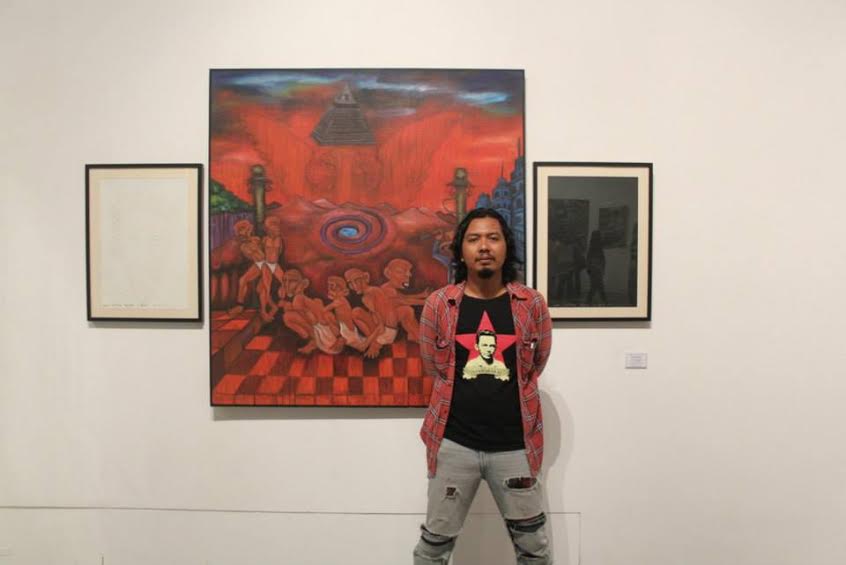
Made Bayak is a Balinese artist, painter, musician, educator and environmental activist.
Through is ongoing project Plasticology – a concept that fuses the words “plastic” and “ecology” – he is exploring Bali’s ecological, social, cultural and political issues. Plasticology develops across different media Plasticology and is associated to an educational campaign against plastic trash.
Plasticology is your long term project that combines art with environmental issues. Bali in fact suffers with plastic pollution. When did you first become interested in that?
I started to make art related to plastic issues in 2001, when I was studying visual art at the Indonesian Institute of the Arts in Denpasar. The first plastic-related project I created was an outdoor installation called PLASTILITICUM. The name is from human history periods, like Megalithic, Palaeolithic, etc. I imagined that in the future people would research about a time in the past where plastic polluted the earth. Therefore the artefacts they will find won’t be stone tools, but plastic objects. At my first solo exhibition at Sika gallery at Ubud in 2008, I created some kinetic objects and sculptures using waste and ready-made materials such as frying pans, wood from the beach, sandals, plastic bottles and broken toys. At the end of 2010 I started experimenting with flatten plastic wastes on a canvas. Since that time I created a series of paintings – I consider them paintings because they are two-dimensional – and I decided to use them for my art project. Plasticology though is not just about paintings and art, but it rather tackles problems directly. We have organized presentations, workshops, river and the beach cleaning up etc.
Read More
When people ask me about my routine, what I can say is that it is constantly changing. After an intense July, I’m finally back in uneventful Sorrento, Italy, and I couldn’t be happier about it. In sultry Rome I was super-busy setting up the screening of Indonesian video art, so I wasn’t really able to keep a routine, which was good. In fact, my modus operandi entails intense and exciting weeks, followed by weeks of just concentrating getting the “offstage” work done. Which means a solid 8 hours a day. Then I grow restless and I leave for the next adventure. I also like the idea that thanks to the internet you can work remotely to your next mission. There is something inherently powerful in working from a remote costal town in Italy, contacting artists and magazines from all over the world. So that’s how an ideal July-August workday looks like for me (if I manage to retain myself from playing guitar all day)
Read More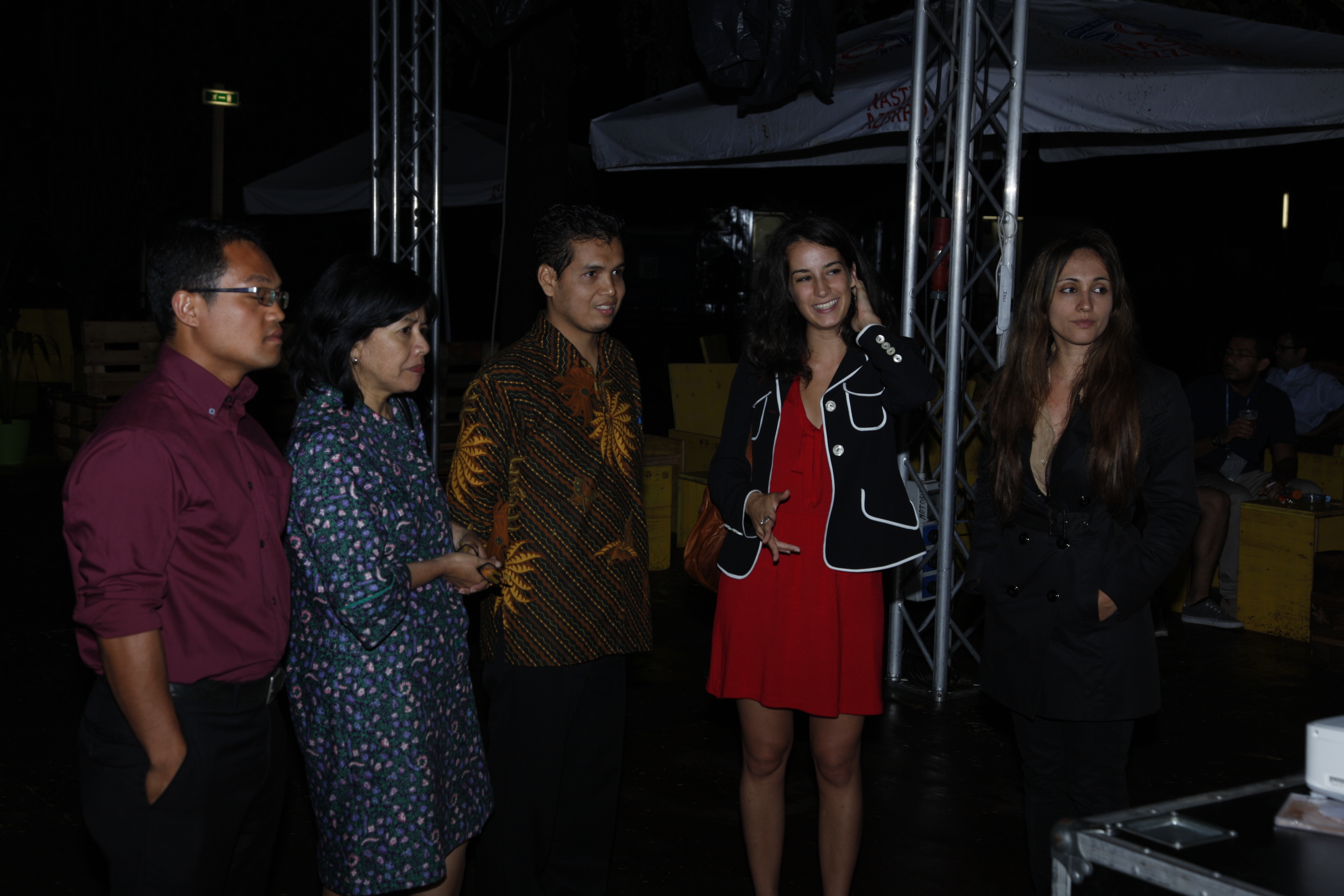
On July 18, right after an unexpected rain in Rome, we held a private screening of “Indonesia – Orienti, Visioni Contemporanee” for three members of the Embassy of the Republic of Indonesia in Italy. MNAO Contemporary’s Chief Curator Valentina Levy and I had an informal chat with Counsellor Nindarsari Utomo and Third Secretary Tinus Zainal. We discussed the difficulty to keep alive tradition in relation of Krisna Murti’s “Empty Theather”. We also dwelt on the value of documentation and national identity with Tintin Wulia’s video and we observed how the young generations of Italians can easily relate to SlavePianos and Punkasila’s work. The Embassy of the Republic of Indonesia in Italy is constantly promoting cultural events across the two countries, and it has been great to see how visual art can be part of that. Here a couple of pictures!
Read More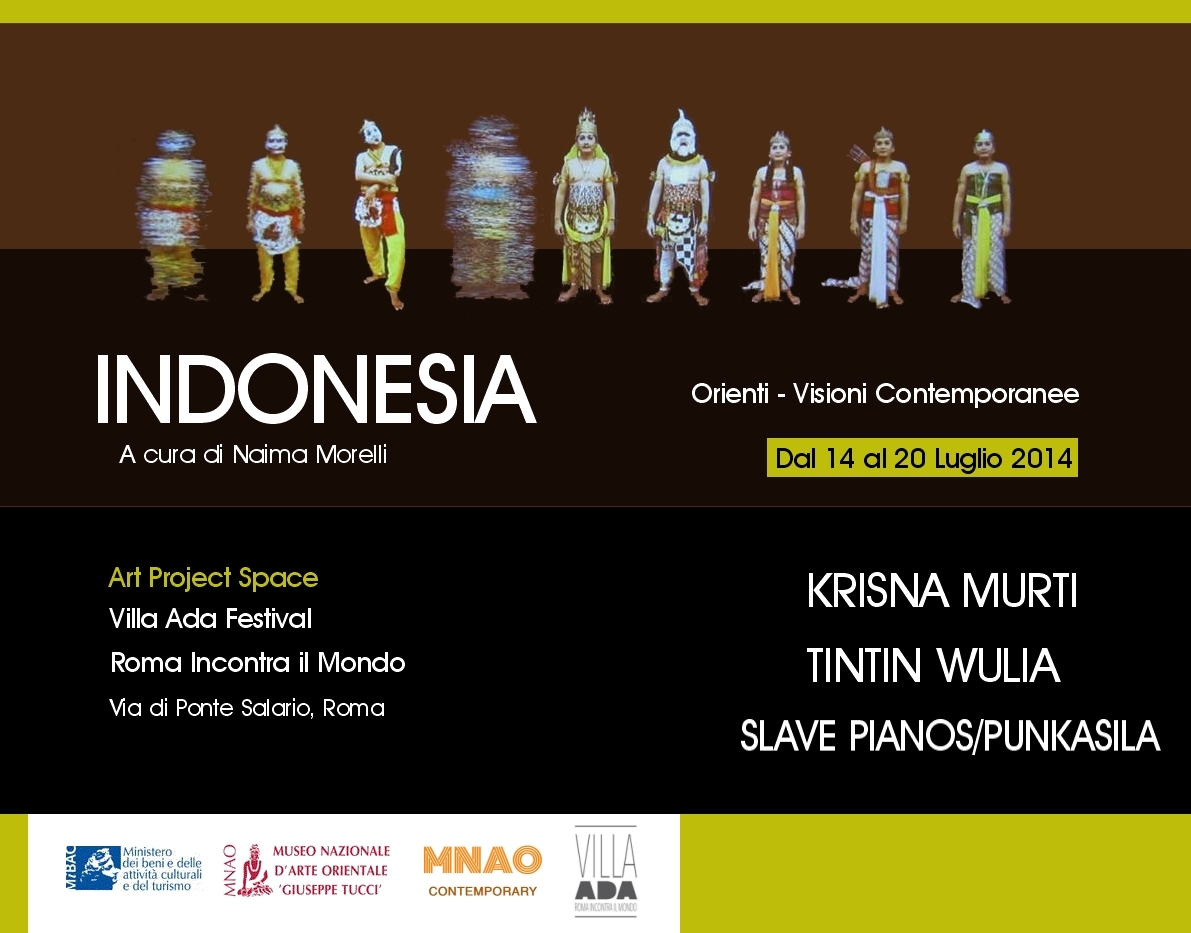
Dal 14 al 2o Luglio curerò una rassegna di video arte indonesiana nell’ambito del Festival di Villa Ada. L’iniziativa è stata organizzata da MNAO Contemporary, il programma di arte contemporanea del Museo Nazionale d’Arte Orientale Giuseppe Tucci di Roma, e si focalizza su diversi paesi asiatici. L’inaugurazione è domani sera dalle 9 in poi… intanto beccatevi il comunicato!
Villa Ada Festival Roma Incontra il Mondo presenta…
“ORIENTI – VISIONI CONTEMPORANEE”
Programma di video-proiezioni ed installazioni di artisti contemporanei asiatici diretto da Valentina Gioia Levy, con la collaborazione di Elena Abbiatici e Naima Morelli
Presso l’Art Project Space
Adagio Bar
A partire dal 4 luglio
INDONESIA 14 – 20 Luglio
A cura di Naima Morelli
14 – Presentazione scena artistica indonesiana e introduzione al lavoro dei tre artisti in mostra.
15/16 – Krisna Murti – Empty Theather – Video installation (multi-channel video), DVD 3 projections, 3’58’’, loop, sound, 2010.
17/18 – Fallen –Tintin Wulia – Video projection (single-channel), 18’43”, loop, 2011
19/20 – The Lepidopters – Slave Pianos and Punkasila – Video projection (single-channel), loop, 2014
Proiezioni dalle 21 in poi
Per la settimana dedicata all’Indonesia verranno proiettati tre video che rappresentano alcune sfaccettature della complessa e variegata scena artistica locale in rapido sviluppo.
Krisna Murti e Tintin Wulia sono pionieri della video arte in Indonesia. Entrambi cominciano a lavorare con i new media all’alba della caduta del regime del dittatore Suharto nel ’98, in un clima di libertà espressiva fino a quel momento negato.
Punkasila invece è un gruppo artistico nato a Yogyakarta nel 2007 da una residenza all’Indonesian Visual Art Archive, allora Yayasan Seni Cemeti, di Danius Kesminas. Il gruppo originale di Punkasila conta sette giovani artisti indonesiani più Kesminas, ma è costantemente in espansione e aperto a nuove collaborazioni, tra cui quella con Slave Pianos per questo video.

The other day I was reading this interesting interview on Design Sponge to business owner Jess Lively. Jess pointed out that there are four questions everyone should ask themselves before starting a business, or while running it. These question have subconsciously run into my mind all the time, but now I really wanted to put them “on paper”. The answer we give to these questions is ultimately what makes you keep going through a bad day and what can probably stop you making things half heartedly. It is a powerful reminder to do what you can with what you have and not be scared to figure things out along the way. Here my answers; I’m sure many arts writers and curators can relate to.
1. Why are you starting this business?
Because I love writing and connecting with people. What motivates me is a huge curiosity about the world and the human beings inhabiting it. I enjoy hearing people’s stories and retell them through my own writing. I’m usually enriched and energized by a good conversation, and at times also moved. As a journalist and interviewer I always bear in mind the motto: “La vita è l’arte dell’incontro” (Life is the art of the encounter).
Read More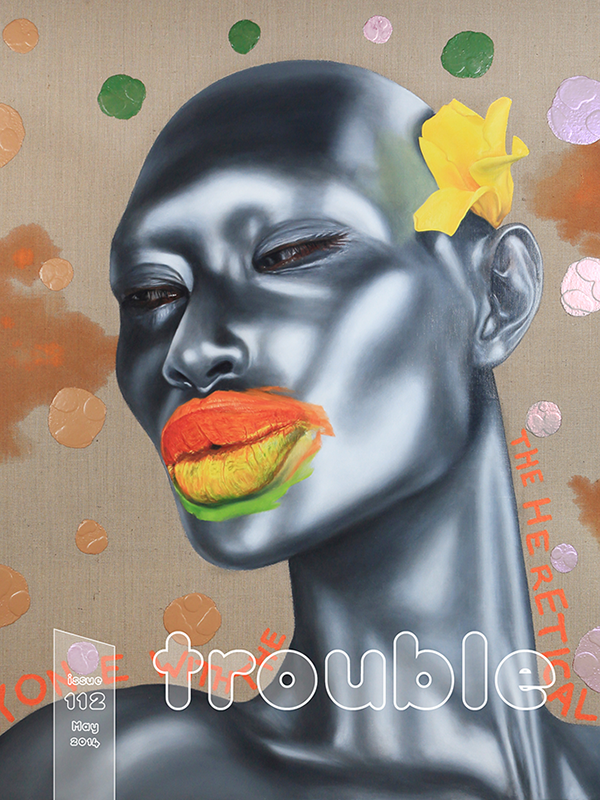
My interview with artist Ashley Bickerton “Artists are dyed poodles dancing through fiery hoops for the one percent”, is the cover story of the Australian magazine Trouble. (My second cover story on Trouble after Bindi Cole!)
The interview is part of my reportage about contemporary art in Indonesia.
Here the link to the interview
Here the link to the online version of the magazine
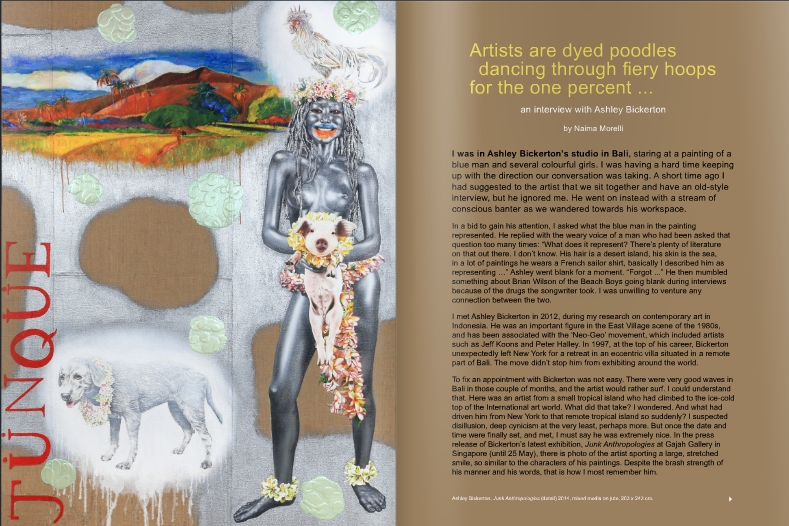
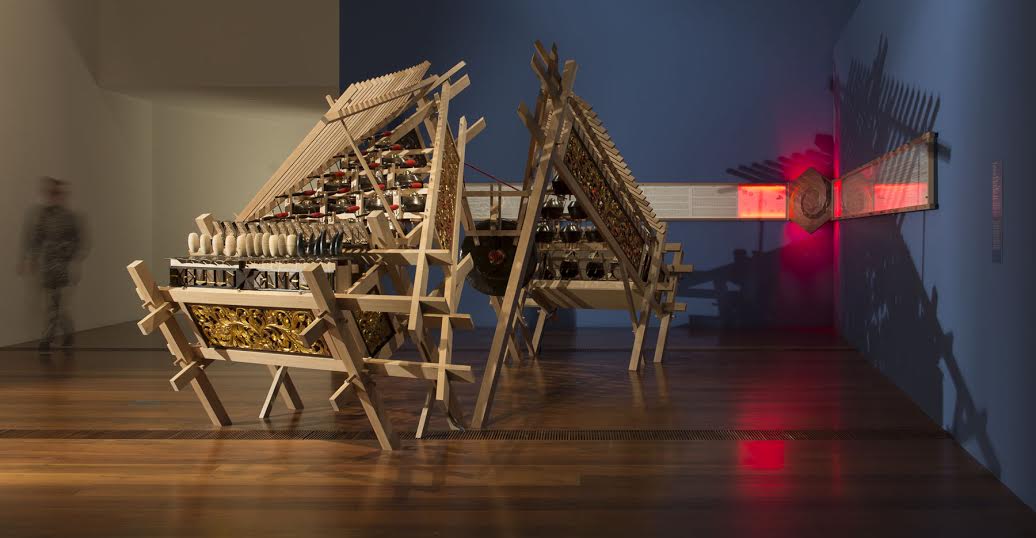
What the National Gallery of Victoria is trying to do with the Melbourne Now exhibition is to define the identity of Melbourne through its cultural practices, with a special focus on contemporary art.
I’m in Italy now, ironically writing my book about emerging artists in Melbourne, so I couldn’t visit the exhibition. Luckily my Australian friends and the artists that I have interviewed always keep me updated.
Some time ago I got a mail from artist Danius Kesminas, who told me about his new project with Slave Pianos for Melbourne Now, called Gamelan sisters (Sedulur gamelan). I posted some images, which gives you the feeling of this evocative machinery. On Slave Pianos’ website I find more information about it:
“Sedulur Gamelan (Gamelan Sisters) consists of two interlocking wooden structures that reconfigure elements of traditional Javanese architecture through the De Stijl philosophical principles of neoplasticism to create an abstraction of an 18th century double grand piano.
Read More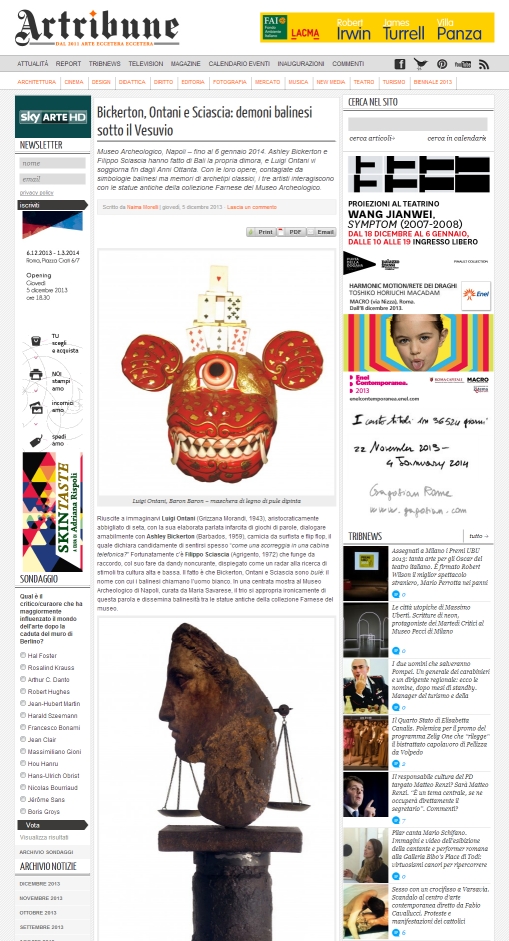
The Italian magazine Artribune has just published my review of the Bali Bulè exhibition at Museo Archeologico in Naples, featuring artists Bickerton, Ontani and Sciascia.
Read More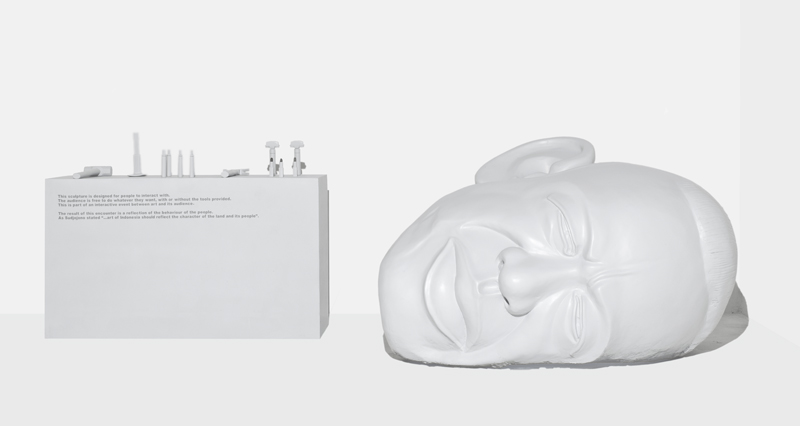
I met Marco Cassani in Bali during my reportage about contemporary art in Indonesia. What supposed to be an interview has become a lively chat about Marco’s art, hallucinogenic experiences and, of course, Bali. A month ago he sent me this mail about his new work that is going to be exhibit at “Imagining Indonesia, Tribute to S.Sudjojono” on the 23rd of November at Tonyraka Gallery in Bali:
Dear Naima,
How are you?
I am sending you the picture of my new work for the group exhibition
Tribute to Sudjojono at Tonyraka gallery on November, 23rd.
The work, entitled ‘CHANCE Project 2, Tribute to S. Sudjojono’, consists in:
1) a sculptor that represents the Sudjojono head (cement, 140 x 90 x 90 cm)
2) a box (wood, 120 x 70 x 45 cm) with a text (“This sculpture is designed
for people to interact with. The audience is free to do whatever they
want, with or without the tools provided. This is part of an interactive
event between art and its audience. The result of this encounter is a
reflection of the behaviour of the people. As Sudjojono stated Еarth of
Indonesia should reflect the character of the land and its people.”)

Since no one cares about the 55th Venice Biennale anymore, I feel like sharing my definitive thoughts about my favourite pavilion, without anyone there to contradict me.
So, chart lovers, my favourite pavilion was the Indonesian one, curated by Rifky Effendy.
In no other pavilion the installations of different artists work so perfectly together. The show almost looked like one single artist and yet it encapsulated such a richness of discourses.
If you were at the Venice Biennale in October, you would have seen me wandering in the Arsenal looking for the Indonesian Pavillion.
I actually overshot the main entrance, so I came in by the back door.
It was dark inside, and there was a soft music that I didn’t notice in the first place. The music though ended up being a background noise influencing the entire experience of the pavilion.
The soundscape was actually by Solo composer Rahayu Supanggah, the guy who reinvented traditional Indonesian music. For the Biennale’s composition he was inspired by the theme of the pavilion, which was “Sankti”.
As the press release stated, Sankti is a sanskrit word that refers to the primordial cosmic energy and the personification of the divine, feminine creative energy, as well as indicating change and liberation.
The first dark-metal work I encountered immediately struck me with his expressive power.
A group of man wearing a Muslim hat were sitting at a table. One man was laying with his head on the table, like someone who had been shot or something. One man was pointing his finger to another gentleman, who looked baffled. If you looked better at these two figures and you would notice that their legs where stretched under the table so to touch each other.
But the figure that really stood out was a matriarch in traditional clothes, upright at the end of the table. She was bringing a hand at his chest like saying: “Who, me?”
A weird lamp was falling from the ceiling, almost touching the table. It was shaped like something between an octopus and a tropical fruit.




